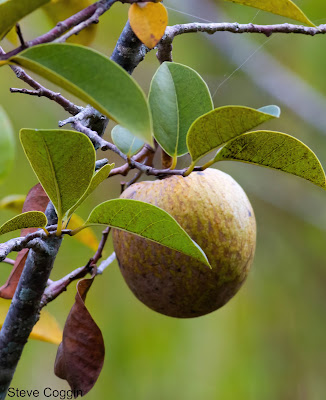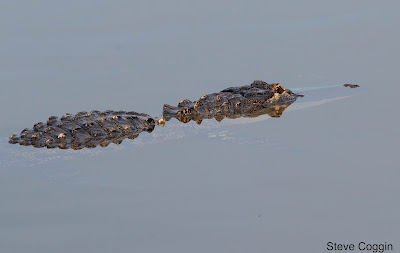 |
| Tick Seed (Bidens aristosa). One flower is being pollinated by a bee-mimic Hover Fly (Syrphidae). Rowan County, North Carolina. |
In spring the palette of wildflower color runs toward blue and purple, but as summer eases into fall the predominate flower color is yellow. Many of these yellow blooms are sported by members of the Composite family, the Asteraceae. This large family includes many familiar plants like sunflowers, asters, daisies and dandelions. Many of the fall Composites look similar and are difficult to tell apart. Some folks call then DYCs, Damn Yellow Composites.
Composite is no longer the accepted name of the family Asteraceae but is descriptive. What looks like a flower in many Composites is actually a group of flowers, an inflorescence. Many inflorescences of the Asteraceae are a composite of two distinct types of flowers, disk flowers and ray flowers. Take a sunflower for example; the outer edge that appears to be petals is really a group of ray flowers and in the center are hundreds of disk flowers. This display looks like a single giant flower to insects that pollinate the plant.
Here is a collection of DYCs of autumn we see in our little slice of North Carolina.
Smallanthus uvedalia, Bear’s Foot is an impressive plant. It has large lobed leaves that resemble a bear’s paw. This tall plant blooms in late summer and fall with an inflorescence of yellow ray and disk flowers.
 |
| Bear Paw, Smallanthus uvedalia, with its large leaves and yellow flowers, blooming by a stream. Mecklenburg County, North Carolina. |
Another tall DYC is Wingstem (Verbesnia alternifolia). It also has yellow ray and disk flowers but the disk flowers are sparse and that gives the inflorescence an unkempt look. As the common name suggests, the stems of the plant has ridges that look like wings running down their length. Wingstem usually grows along the sunny edges of streams.
 |
| Verbesnia alternifolila, Wingstem, has yellow ray and disk flowers. The stems are winged. This one is being pollinated by a Scolid Wasp, Scolia dubia. Rowan County, North Carolina. |
 |
| Wings on the stem of Wingstem. Rowan County, North Carolina. |
Tickseed, Bidens aristosa, grows in open fields and edges of woods. This is another plant with yellow ray and disk flowers. The fruits of Tickseed have two prongs and attach to passing animals or the pants of hikers, spreading the plant.
 |
| Tick Seed flowers. Rowan County, North Carolina. |
 |
| Tick Seed Fruit. Rowan County, North Carolina. |
Bidens bipinnata is a close relative of Tickseed with the common name Spanish Needles. It has deeply dissected leaves and makes small inflorescences with just a few yellow ray flowers. The fruits are long with prongs at the end and are dispersed by animals in much the same way as Tickseed.
 |
| Spanish Needles (Bidens bipinnata). Henderson County, North Carolina. |
Purple Sneezeweed (Helenium flexuosum) has yellow ray flowers and purple-brown disk flowers. The ray flowers are tipped with three lobes. The leaves and flowers of this plant were once dried and ground into snuff, giving rise to its common name.
 |
| Purple Sneezeweed (Helenium flexosum). This DYC has yellow ray flowers and brownish purple disk flowers. Henderson County, North Carolina. |
The most emblematic DYC of autumn is Goldenrod (Solidago sp.). There are over 30 species of Goldenrod in our area and plants fill the fields and line the roadsides with their yellow flowers in fall. Goldenrod makes numerous, small inflorescences containing both ray and disk flowers. These are arranged along the tips of stems making sprays of gold.
 |
| A field of Goldenrod (Solidago sp.). Rowan County, North Carolina. |
 |
| Closeup of the yellow ray and disk flowers of Goldenrod. Rowan County, North Carolina. |
Fall is flying by and the DYCs are starting to fade. But amateur botanists everywhere look forward and dread the coming of autumn and the reappearance of these challenging yellow flowers.
 |
| Tick Seed flowers. Rowan County, North Carolina. |







